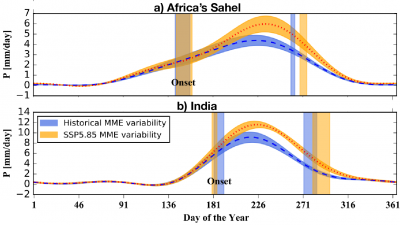Projecting Regionally Distinct Future Changes in Monsoons
The UC Berkeley Monsoon Extremes team analyzed simulations of the future seasonal cycle of tropical rainfall, finding two main patterns: a lengthening and amplification of the rainy season in the two largest Northern Hemisphere monsoon regions, and a contraction and weakening of the rainy season in the two largest Southern Hemisphere regions. Rainy season weakening is projected to occur where the equator-to-pole difference in atmospheric energy content increases. A new “relative moist static energy” metric is defined as the difference between local atmospheric energy content and the tropical mean value; changes in this metric correlate well with changes in the length of the rainy season.
Monsoon systems and their variability greatly influence a large fraction of the global human population. Variations in the timing of the start and end of the monsoon season and in seasonal precipitation totals have important consequences for energy generation, agriculture, human health, and property loss (e.g. due to landslides, floods, and fires). A thorough assessment of future projections of the annual cycle of monsoon precipitation is thus of great consequence. However, the effort to reliably project future monsoon rainfall has been hindered by model bias, incomplete understanding of the mechanisms governing future changes, and the use of disparate methodologies. This study addresses all of these issues by analyzing the historical and future seasonal cycle of precipitation in six different monsoon regions, as simulated by a collection of global climate models. The study also provides a physically based understanding of the projected changes using a simple energetics framework that incorporates the latent energy stored in atmospheric water vapor.
Projected next-century changes include rainy season lengthening in the two largest Northern Hemisphere monsoon regions (south Asia and central Sahel) and shortening in the two largest Southern Hemisphere regions (South America and southern Africa). A new metric—the relative moist static energy—was defined and shown to explain the projected changes in the length of the rainy season; changes in this metric were also shown to be related to whether the equator-to-pole difference in atmospheric energy content increases in a future climate.

